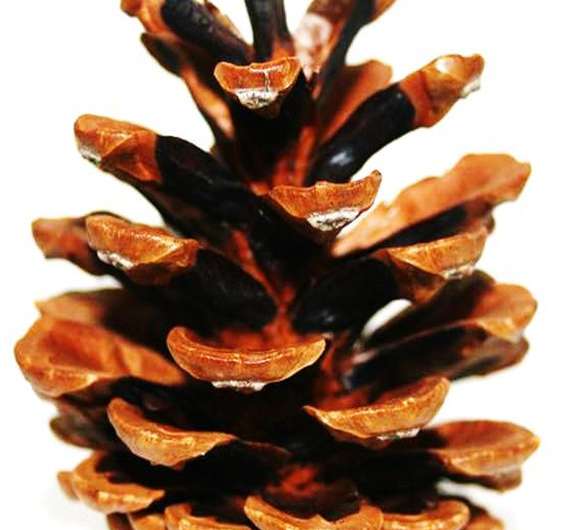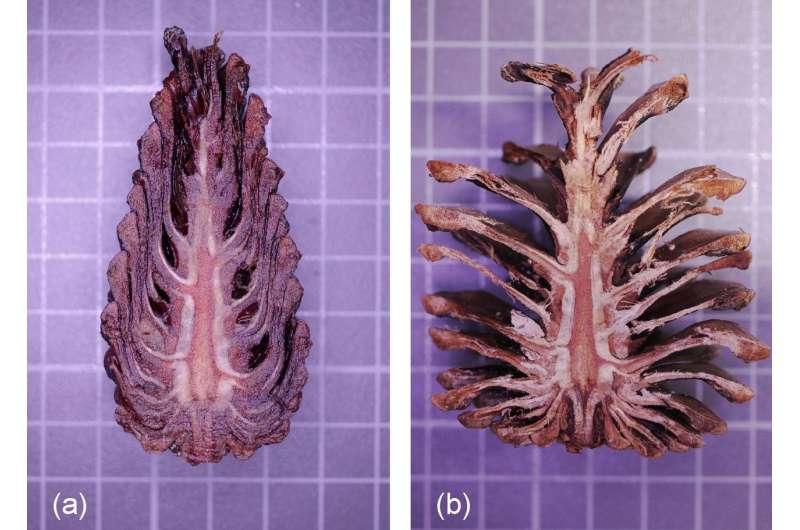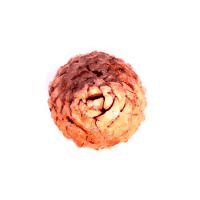Climate-friendly architecture thanks to natural folding mechanisms

A research team from Technical University Munich, University of Freiburg, and University of Stuttgart has reported on the design of mobile building components such as blinds based on naturally occurring solutions. The aim is to outfit them with drive elements that can move without energy input. Pine cones, which have swelling responses causing them to open when moist or close when dry, served as a model.
Worldwide, the use of buildings accounts for 40 percent of total energy consumption. Around half of power consumption is used for climate control. Although blinds and other mobile facade elements can be used to optimize the building shell's transparency for heat and light, their electric motors also require energy.
"Sustainable architecture urgently requires new materials if it is to live up to the high energy efficiency and climate protection requirements," says researcher Professor Cordt Zollfrank. At the Chair of Biogenic Polymers on the Straubing Campus for Biotechnology and Sustainability of the TUM, he is researching the related basic principles. His goal is to develop drive elements and actuators able to convert signals into mechanical movements without consuming energy.
Together with architects, civil engineers and botanists, he has found novel methods using natural mechanisms to improve the energy balance of buildings. In a joint article in the specialist journal Advanced Materials, the team reports on the status of the research in this area, and demonstrates the possibilities of the models from the plant world.

Material replaces motor
Ripe pine and fir cones close their scales when it rains in order to protect the seeds. However, when it is dry, they open up to release them. During this movement, the composition of the cell walls plays a crucial role. They are composed primarily of lignin, which does not swell much, and cellulose, which does. Due to the different orientation of the cellulose fibrils in the tissue of the scales, they curve inward when humidity is high, and outward when it is dry.
"The exciting thing about this is that the energy for these movements does not come from metabolic processes, but solely from physical mechanisms and material properties," says Professor Zollfrank. Via the combination of materials with varying swelling propensities, he has developed biomimetic drive elements called actuators. These elements are composed of two layers of materials that absorb varying amounts of liquid and behave similarly to their naturally occurring models.

However, before they can be used on a large scale in architecture, the material researchers still need to solve one problem affecting scalability: The larger the cell or the tissue, the longer the time required for the water to penetrate its pores. Something that takes two hours in a pine cone takes several years in a building. Hence, in order to use the hydraulic dynamics of pine cones for applications in architecture, researchers must overcome a physical limit.
For this purpose, Zollfrank proposes a type of restructuring process at the material level. "We decouple the tissue size and take the whole thing to the magnitude of an individual cell," he explains. Via cleverly chosen cross-links, a loose cell complex is created whose individual components nevertheless still act like individual cells and absorb water extremely rapidly.
"The question now is how such cross-links can be designed as efficiently as possible and how to create them in any size," says Zollfrank. However, for later practical applications, he can also imagine porous biopolymer materials whose pores are filled with an extremely hydrophilic liquid (hydrogel). Material researchers are already working on this. It is only a matter of time before they determine which solution will ultimately make its way into the architecture of the future.
More information: Simon Poppinga et al, Toward a New Generation of Smart Biomimetic Actuators for Architecture, Advanced Materials (2017). DOI: 10.1002/adma.201703653
Journal information: Advanced Materials
Provided by Technical University Munich




















